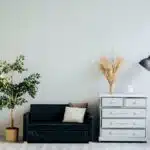Designing a bedroom can be a daunting task, especially when it comes to considering various factors such as space, color, and furniture. However, when you base your design on essential principles, it becomes more effortless to create a beautiful and functional space that suits your needs.
To design your perfect bedroom based on fundamentals requires careful consideration of factors such as lighting, color psychology, and layout. Each of these elements plays a vital role in creating an ambiance that is conducive to relaxation and restful sleep. As an interior designer, I have helped numerous clients create their ideal bedroom spaces by focusing on the fundamental principles of design. In this article, we will explore how you can use these principles to transform your bedroom into a haven of peace and tranquility.
Understanding Lighting And Its Impact On Your Bedroom Design
Lighting plays a crucial role in bedroom design, as it can greatly impact the overall ambiance and mood of the space. One important concept to consider when designing your perfect bedroom is layered lighting. This involves incorporating multiple sources of light, such as overhead lighting, bedside lamps, and accent lighting, to create a well-lit and dynamic space. By strategically placing different types of lighting throughout your bedroom, you can highlight certain areas and create a cozy and inviting atmosphere.
Another key consideration when it comes to lighting design is the difference between warm and cool lighting. Warm lighting tends to have a yellow or orange tint, while cool lighting has a blue or white tint. Depending on your personal preferences and the desired mood for your bedroom, either warm or cool lighting may be more appropriate. For example, warm lighting can create a cozy and relaxing environment for reading or unwinding at the end of the day, while cooler lighting may be better suited for getting ready in the morning.
Understanding how to use layered lighting and choosing between warm vs cool lighting are just two aspects of creating the perfect bedroom design. By taking into account these important considerations, you can create a space that is both functional and visually appealing. In the next section, we will explore another critical element of bedroom design: the psychology of color and its role in creating a relaxing space.
The Psychology Of Color And Its Role In Creating A Relaxing Space
Like music, color can influence human emotions and behavior. Interior designers are aware of the power of color psychology in creating a relaxing space. The colors used in your bedroom design can affect your mood, energy level, and quality of sleep.
Color psychology in branding and marketing is widely used to evoke emotions and create an association with a particular product or service. Similarly, choosing the right colors for your bedroom can help you feel calm, energized, or even romantic. For instance, blue has been found to lower blood pressure and heart rate, making it ideal for promoting relaxation.
When selecting colors for your bedroom walls, consider using neutral shades like beige or gray as they create a warm atmosphere without being too overwhelming. You may also opt for pastel hues such as lavender or mint green that have calming effects on the mind and body. Lastly, accent pillows and throws in bold colors like red or orange can add warmth to your space while creating a sense of coziness.
Incorporating color psychology into your bedroom design is just one aspect of creating a relaxing space. In the next section, we will explore how choosing the right furniture can enhance the overall ambiance of your room.
Choosing The Right Furniture For Your Bedroom
Selecting the right furniture for your bedroom is essential in creating a cohesive design that fits your personal style and needs. When it comes to creating the perfect bedroom, mixing styles can be a great way to add character and personality to the space. However, it’s important to find a balance between different styles so that they complement each other rather than clash.
One of the most important factors in choosing bedroom furniture is space optimization. You want to make sure that your furniture fits comfortably in your room without feeling cramped or cluttered. Consider investing in multi-functional pieces such as storage beds or dressers with built-in mirrors to maximize storage while minimizing the amount of furniture you need.
When shopping for bedroom furniture, keep in mind the overall theme and color scheme of your room. Choose pieces that will enhance and complement these elements rather than detract from them. Remember, your bedroom is a place where you should feel relaxed and at peace, so opt for pieces that are comfortable and functional as well as aesthetically pleasing. By selecting the right furniture for your bedroom, you can create a space that is both beautiful and practical.
Transition: Now that you’ve selected the perfect furniture for your bedroom, it’s time to think about creating a functional layout that maximizes both space and comfort.
Creating A Functional Layout For Your Bedroom
Maximizing space in a bedroom is key when creating a functional layout. Prioritizing the placement of furniture so that it is both aesthetically pleasing and provides ample space for movement is important. When planning furniture placement, it is important to consider the size and function of the furniture pieces, as well as the desired traffic flow. Strategically positioning furniture in a bedroom can help to create an efficient and organized space.
Maximizing Space
To create a functional layout for your bedroom, maximizing space is essential. This can be achieved through the use of multi-functional furniture and utilizing vertical space. By doing so, you can create a stylish and organized bedroom that meets all your needs.
One way to maximize space is by choosing multi-functional furniture pieces. For instance, a bed with built-in drawers or a sofa that doubles as a guest bed can save valuable floor space while providing additional storage and seating options. Other examples include ottomans that open to reveal storage compartments, desks that fold down from the wall, and wardrobes that have pull-out shoe racks.
Another way to make the most of your bedroom’s space is by utilizing vertical space. Wall-mounted shelves, hanging organizers, and tall dressers are all great ways to add storage without taking up too much floor area. Additionally, installing curtains or room dividers can help separate different areas of the room while also adding visual interest.
By incorporating multi-functional furniture and utilizing vertical space, you can design a functional layout for your bedroom that maximizes every inch of available space. With careful planning and attention to detail, you can create a stylish and comfortable sanctuary where everything has its place.
Planning Furniture Placement
When creating a functional layout for your bedroom, furniture arrangement plays a crucial role in optimizing the space. Spatial planning is necessary to ensure that the furniture pieces complement each other and efficiently use the available area. A well-planned furniture placement can enhance the room’s overall functionality and aesthetic appeal.
Before placing any furniture, it is important to take accurate measurements of your bedroom’s dimensions. This will help you determine which pieces fit best and allow you to create a scaled layout on paper or using a digital tool. Once you have your plan in place, start arranging the larger items such as the bed, dresser, or wardrobe, considering factors like traffic flow and natural light sources. Then, add smaller items such as nightstands or chairs that complement and balance out the bigger ones in terms of size and style.
Another essential aspect of planning furniture placement is creating zones within your bedroom. By separating different areas for sleeping, dressing up, working or relaxing, you can optimize the room’s functionality while maintaining an organized and harmonious look. For instance, placing a tall shelf between your bed and wardrobe can act as both a room divider and storage unit. Or positioning a desk near a window can provide natural light while also creating an inspiring workspace.
In essence, proper furniture placement requires careful consideration of function, form and aesthetics. By taking into account spatial planning, zoning techniques and personal preferences when selecting and arranging your bedroom’s furnishings, you can create an efficient layout that caters to all your needs in style.
Maximizing Storage Space In Your Bedroom
After creating a functional layout for your bedroom, the next step is to maximize storage space. Let’s take the example of a small bedroom with limited storage options. Utilizing under bed space can be a game-changer in such situations. Investing in under bed storage containers or opting for a bed with built-in drawers can provide ample storage space without taking up any additional floor area.
Closet organization tips are another way to increase storage space in your bedroom. Begin by decluttering and getting rid of things you no longer need or use. Next, categorize your clothing and accessories and invest in closet organizers such as hanging organizers or drawer dividers to make everything accessible and easy to find. Additionally, consider using the back of your closet door for shoe racks or hooks for bags and scarves.
By incorporating these storage solutions, you’ll have more room to play around with décor elements like textures and fabrics for a cozy atmosphere. From plush blankets to textured throw pillows, there are endless ways to add warmth and comfort to your bedroom. By selecting textiles that complement each other and layering them thoughtfully, you can create a luxurious retreat that’s both stylish and comfortable.
Incorporating Textures And Fabrics For A Cozy Atmosphere
Soft furnishings such as blankets, pillows, and cushions can add texture and comfort to a bedroom’s atmosphere. A color palette of muted tones can help to create a soothing and cozy atmosphere. Textured accents such as throw rugs, curtains and area rugs can help to further bring together the soft furnishings and color palette. Wallpaper can be used to add depth and texture to walls, while also creating an inviting atmosphere. Furniture pieces with intricate detailing can add a touch of texture to the bedroom. Fabrics such as velvet, linen and cotton can be used for upholstery, bedding and other furnishings to create a textured look.
Soft Furnishings
To create a cozy atmosphere in your bedroom, soft furnishings play a vital role. Choosing the right color scheme for your soft furnishings can help to enhance the overall ambiance of your space. When selecting colors, it is essential to consider the existing color palette of the room and choose colors that complement or contrast with it. Neutral tones like beige, cream, and gray are versatile choices for soft furnishings as they blend well with any decor style.
Mixing and matching different textures in your bedroom design can add depth and interest to your space. Combining plush fabrics like velvet or faux fur with natural materials such as cotton or linen creates a welcoming and comfortable environment. You can also experiment with patterns by incorporating striped or floral prints into your cushions or throws to add visual interest. When choosing fabrics for your soft furnishings, make sure they are durable and easy to clean.
Incorporating soft furnishings into your bedroom design is an excellent way to create a cozy atmosphere that promotes relaxation and restful sleep. By choosing the right color scheme and mixing different textures, you can create a space that feels warm, inviting, and comfortable. Remember always to keep functionality in mind when selecting soft furnishings so that they serve both aesthetic and practical purposes in your room’s design.
Color Palette
When it comes to creating a cozy atmosphere in your bedroom, incorporating various textures and fabrics is an excellent way to achieve that goal. However, the colors you choose can also play a vital role in enhancing the overall ambiance of your space. As an interior design expert, I recommend considering color psychology when selecting the color palette for your soft furnishings. For instance, warm colors such as reds and yellows can create a sense of comfort and coziness, while cool colors like blues and greens promote relaxation.
In addition to color psychology, color coordination is also crucial when selecting soft furnishings for your bedroom. You want to choose colors that complement or contrast with your existing decor style while maintaining a cohesive look throughout the room. The general rule is to stick with a maximum of three colors in your color scheme – one main color, one secondary color, and one accent color. Neutral tones like beige, cream, and gray are versatile choices for soft furnishings as they blend well with any decor style.
Overall, incorporating the right color palette into your soft furnishings can help create a warm and inviting atmosphere that promotes relaxation. By considering both color psychology and coordination when selecting colors for your cushions or throws, you can achieve a cohesive look that enhances the overall design of your bedroom. Remember always to keep functionality in mind when selecting soft furnishings so that they serve both aesthetic and practical purposes in your room’s design.
Textured Accents
When it comes to creating a cozy atmosphere in your bedroom, incorporating various textures and fabrics is an excellent way to achieve that goal. In addition to color psychology and coordination, using textured accents can add depth and interest to your space. Using textured wallpaper can create a focal point in your room or add dimension to a feature wall. This can be complemented by adding textured bedding, such as a knitted throw or faux fur pillows, which add both visual and tactile interest.
One way to incorporate textured accents is by layering different fabrics and materials. For instance, you could mix a smooth linen duvet cover with a chunky knit throw or velvet pillows. This creates a sense of richness and depth in your space while keeping it visually interesting. You can also use different types of textures, such as woven or embroidered patterns, to add intrigue without overwhelming the space.
Another way to use textured accents is by incorporating natural elements into your soft furnishings. This could include using organic cotton bedding or adding a sheepskin rug on the floor. These natural textures bring an earthy warmth into your space while still maintaining the cozy atmosphere you’re trying to create. Overall, adding textured accents can help elevate the design of your bedroom while creating a warm and inviting environment that promotes relaxation for years to come.
Tips For Choosing The Right Bedding
When it comes to designing your perfect bedroom, selecting the right bedding is crucial. Your bedding not only serves as a functional aspect of your bedroom but also adds a decorative element to your space. Choosing the perfect color scheme for your bedding can help set the tone for the rest of your room’s decor. It’s essential to choose colors that complement each other and create harmony in your overall design.
When selecting materials for your bedding, consider both comfort and style. Cotton is a popular choice due to its softness and breathability, making it ideal for year-round use. However, if you’re looking for something more luxurious, consider silk or satin bedding. These materials are soft and smooth to the touch, adding a touch of elegance to any bedroom decor.
Keep in mind that quality bedding can be an investment, so it’s important to take care of it properly. Follow manufacturer instructions when washing and drying your bedding to ensure longevity. By choosing the right color scheme and materials for your bedding, you’ll create an inviting atmosphere in your bedroom that promotes relaxation and comfort. In the next section, we’ll discuss how you can add personal touches to your bedroom decor without breaking the bank or compromising on style.
Adding Personal Touches To Your Bedroom Decor
After choosing the right bedding, it’s time to add some personal touches to your bedroom decor. Incorporating personal style into your bedroom can make it feel like a sanctuary that reflects your unique taste and personality. Whether you prefer a minimalist look or love bold patterns and bright colors, there are many DIY decor ideas that can help you achieve the perfect look for your space.
Firstly, consider adding artwork that speaks to you. Displaying pieces of art that resonate with you can bring an extra layer of meaning and inspiration to your room. From framed prints to original paintings, there are many ways to incorporate art into your bedroom decor. You could also create a gallery wall featuring photos of loved ones or travel souvenirs for a personalized touch.
Secondly, use textiles such as throw pillows, blankets, and rugs to add texture and warmth to your bedroom. Mixing different fabrics like velvet and linen can create a cozy atmosphere while adding visual interest. Layering several textures in the same color family will give off an elevated look.
Lastly, incorporating plants and natural elements is an excellent way to achieve a calming effect in your bedroom. Plants not only purify the air but also add life and freshness to the space. You could display succulents on floating shelves or place large leafy plants in corners of the room.
Incorporating personal style into bedroom decor can be challenging but rewarding once achieved. By following these DIY decor ideas, you’ll be able to design a space that feels like home while reflecting your unique personality through bold artwork choices, layered textures from textiles such as blankets and rugs made from mixed fabrics including velvet or linen for added warmth during colder seasons; making sure not forget about incorporating nature by including greenery throughout with plants placed strategically around corners where they’re needed most!
Incorporating Plants And Natural Elements For A Calming Effect
Incorporating plants and natural elements in your bedroom design can create a calming effect that can help reduce stress and improve overall well-being. This concept is known as biophilic design, which promotes the connection between humans and nature. The benefits of biophilic design are numerous, including improved air quality, reduced noise levels, and increased relaxation.
One way to incorporate plants into your bedroom design is by creating a DIY plant wall. This idea not only adds greenery to your space but also acts as a focal point in your room. You can use various types of plants such as ferns, succulents, and ivy to create an impactful display. Another way to introduce natural elements is by incorporating wood furniture or woven textures such as baskets or rugs. These additions create a warm and inviting atmosphere that promotes restful sleep.
By incorporating biophilic design principles into your bedroom decor, you can create a peaceful haven that feels like an escape from the outside world. Adding natural elements not only brings beauty but also several health benefits. Creating a DIY plant wall or introducing wood accents are just some ideas that can be easily incorporated into any budget or style preference. In the next section, we’ll discuss how to take this concept further by creating a focal point in your bedroom design without breaking the bank.
Creating A Focal Point In Your Bedroom Design
Incorporating plants and natural elements in your bedroom can do wonders for your mental health, but it’s not the only key to perfect bedroom design. Another important aspect is creating a focal point that draws the eye and adds visual interest. This can be anything from a statement headboard to a unique piece of artwork, as long as it reflects your personal style and complements the overall decor.
When thinking about decorating styles, consider what speaks to you personally. Do you prefer minimalist aesthetics or bohemian flair? It’s important to choose a style that makes you feel comfortable and at ease in your space. Don’t be afraid to mix and match elements from different styles to create something truly unique. Additionally, DIY projects can add a personal touch to your bedroom and save you money in the process.
While aesthetics are certainly important, don’t forget about practical considerations like proper ventilation. Poor ventilation can lead to stuffiness, mold growth, and other health hazards. Make sure there’s adequate airflow in your bedroom by opening windows or using fans if necessary. A well-ventilated room will help ensure that you get a good night’s sleep and wake up feeling refreshed and energized for the day ahead.
As we move into discussing the importance of proper ventilation in your bedroom, it’s clear that there are many factors to consider when designing your perfect space. By incorporating natural elements, creating a focal point, choosing an appropriate decorating style, and paying attention to practical concerns like ventilation, you’ll be well on your way to creating a beautiful and functional bedroom that meets all of your needs.
The Importance Of Proper Ventilation In Your Bedroom
Proper ventilation is key in designing a perfect bedroom. The importance of air circulation cannot be overstated as it helps to improve the overall air quality in your bedroom. Poor air circulation can lead to unpleasant odors, mold growth, and an increase in airborne allergens that can cause respiratory issues.
Preventing mold growth in your bedroom is crucial for maintaining a healthy living environment. Mold thrives in damp and humid areas, which makes bedrooms with poor ventilation a breeding ground for mold spores. A buildup of moisture on surfaces such as walls, ceilings, and floors can create the ideal conditions for mold growth. Proper ventilation helps to reduce humidity levels by allowing fresh air to flow through your room.
Incorporating proper ventilation into your bedroom design doesn’t have to be complicated. Simple solutions such as opening windows, using ceiling fans or installing an HVAC system can go a long way in improving air circulation and preventing mold growth. By prioritizing proper ventilation during the design process, you’ll not only achieve a stylish and comfortable space but also ensure the health and well-being of those who occupy it.
As we move on to our next topic, another important aspect of designing a perfect bedroom is soundproofing it for peaceful sleep. Creating an environment that is insulated against external noise will help you get better sleep and feel more rested throughout the day.
Soundproofing Your Bedroom For A Peaceful Sleep
Coincidentally, one of the biggest challenges that people face when designing their perfect bedroom is noise pollution. Outside noises such as traffic, honking horns, and loud neighbors can disrupt your sleep and lead to a frustrating morning. Fortunately, there are various soundproofing materials and techniques that you can use to create a peaceful atmosphere in your bedroom.
Soundproofing materials include acoustic foam panels, curtains, carpets, and acoustic tiles. These materials help absorb sound waves and reduce echoes in the room. Additionally, they prevent outside noise from entering the room while keeping sounds inside the room from escaping. When choosing soundproofing materials for your bedroom, it’s essential to consider the texture, thickness, and density of the material to ensure maximum effectiveness.
In addition to using soundproofing materials, there are also several techniques you can implement to reduce noise pollution in your bedroom. These include sealing gaps around windows and doors with weather stripping or draft stoppers. You can also install double-glazed windows or use white noise machines to mask outside sounds. Furthermore, rearranging furniture in your bedroom can also help absorb sound waves and prevent echoes.
Creating a peaceful environment in your bedroom is crucial for getting quality rest at night. By using soundproofing materials and techniques effectively, you can minimize outside noise distractions that might keep you up at night. In the next section, we will discuss how creating a relaxing evening routine can help you wind down after a long day so that you can fall asleep faster and more easily.
Creating A Relaxing Evening Routine To Wind Down
As an interior design expert, I cannot stress enough the importance of creating a relaxing evening routine to wind down after a long day. A well-designed bedroom is not only aesthetically pleasing but also serves as a sanctuary for rest and relaxation. To achieve this, it is essential to create a calming color scheme that promotes tranquility and peace. Soft blues, greens, and grays are excellent choices for bedroom walls, bedding, and curtains.
Incorporating aromatherapy into your evening routine can also help promote relaxation. Using scented candles or diffusers with essential oils such as lavender or chamomile can have a calming effect on both the mind and body. These scents can help alleviate stress, reduce anxiety levels, and promote better sleep quality.
By creating a peaceful atmosphere in your bedroom through color schemes and aromatherapy, you can turn your space into a tranquil sanctuary for rest and rejuvenation. Remember that your bedroom should be a place of comfort where you can escape from the stresses of daily life. In the next section, we will discuss tips for maintaining a clean and organized bedroom to ensure that your space remains an oasis of calmness.
Tips For Maintaining A Clean And Organized Bedroom
As we wind down in the evening, it is vital to have a calming and relaxing environment in your bedroom. A well-designed bedroom can help you achieve this feeling of relaxation. One way to create such an atmosphere is through minimalist decor. This style involves keeping only the essentials in your room, which can reduce visual clutter and promote calmness.
Minimalist decor includes decluttering techniques that can help clear your mind and reduce stress levels. First, get rid of anything that doesn’t serve a purpose in your room. For example, if you haven’t used an item in the past six months, it’s likely unnecessary. Next, organize what remains by finding a designated spot for each item and labeling them accordingly. Remember to keep surfaces clean and tidy by putting away items when not in use.
Incorporating minimalist decor and decluttering techniques into your bedroom design will not only enhance its aesthetic appeal but also promote a calming atmosphere conducive to restful sleep. By removing unnecessary items and organizing what remains, you’ll create more space for relaxation. With these fundamentals in mind, it’s time to bring it all together and design your perfect bedroom based on your unique preferences and needs.
Bringing It All Together: Designing Your Perfect Bedroom Based On Fundamentals
To create a perfect bedroom, it is essential to bring all the fundamentals together. Maximizing space and creating a cohesive theme are two key factors that can transform a bedroom into an ideal sanctuary. Begin by assessing your space and identifying areas where you can maximize storage while keeping it aesthetically pleasing.
Creating a cohesive theme is the next step towards designing your perfect bedroom. This involves selecting colors, patterns, textures, and furniture that complement each other. Consider choosing a focal point in the room, such as the bed or an accent wall, around which you can build the rest of your design elements. Be mindful of proportions and avoid cluttering the space with too many accessories or furniture pieces.
Incorporating functional yet stylish storage solutions such as under-bed drawers or built-in wardrobes can help maximize space without compromising on style. A well-designed closet with ample storage options can also help keep clutter at bay, promoting relaxation and calmness in your bedroom. A cohesive theme combined with smart storage solutions will ensure that your bedroom remains peaceful and organized for years to come.
- Creating a cohesive theme:
- Choose colors, patterns, textures, and furniture that complement each other
- Select a focal point around which you can build other design elements
- Maximizing space:
- Incorporate functional yet stylish storage solutions like under-bed drawers or built-in wardrobes
- Design a well-organized closet with ample storage options
By following these principles of maximizing space and creating a cohesive theme in your bedroom design, you can create an environment that promotes relaxation and calmness. Remember to stay true to your personal style while incorporating practical considerations for maximizing storage. With these tips in mind, you’re well on your way to designing the perfect bedroom sanctuary.
Conclusion
In conclusion, designing your perfect bedroom based on fundamental principles can be a daunting task. However, understanding the impact of lighting, color psychology, furniture selection, and functional layout can significantly enhance your experience and make your bedroom your favorite space in the house. Maximizing storage space, soundproofing for peaceful sleep, and creating a relaxing evening routine are also crucial elements to consider.
A few tips for maintaining a clean and organized bedroom include decluttering regularly, making the bed every morning, and investing in effective storage solutions. Remember that bringing all these elements together is key to designing the perfect bedroom. As an interior design expert, I encourage you to take your time in choosing pieces that resonate with your personal style while keeping functionality at the forefront. Ultimately, creating a space that reflects who you are while promoting relaxation is essential – so go ahead and design away!
Image Credits
- “House in the Village of Rowsley, Derbyshire” by UGArdener (featured)




























